Just wanted to give a little update on the status of our garden. Everything is growing well, happy to see sprouts and
Category: Gardening
Community Garden vol. 2
I know we are “socially isolating,” but I just needed to get to the garden today. We’ve been on a spree
Our Community Garden
If you know me then it’s no secret that I sorely lack a green thumb. Animals have always been my forte, with plants
Some Work Outside
Yesterday my friend Nicole and I took our griffs Reign & Willa to a training day with the Chattahoochee NAVDHA club. Willa (and Reign) have their NAVHDA Natural Ability (NA) tests coming up on September 8, so we were getting in one last good day of training on some live birds with the pros! We had a great day, and were very pleased with how both of our dogs performed. Looking forward to the test! While we were there, I met the cutest little griff puppy (see below), Jax. He is 11 weeks old, and reminded me how cute griff puppies are.
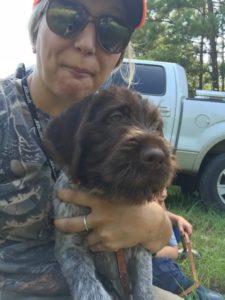
Today I worked outside. I woke up, brewed some hot tea, ate a bowl of granola, and got to work. I had a tentative list of things that I wanted to accomplish, and I’m proud to say that I got every one of them done. I set up some cinder blocks around one side of the rabbitry and filled them with my high quality bunny compost. In the spring I’m going to likely plant some sweet potato vines in them to feed the buns with, but today I planted garlic. I’m hoping I got the cloves in the ground early enough so that they weather the winter and produce next year. I also aerated and re-planted my large wooden planter. I just tossed in some greens (chard, kale, lettuce, etc.) to see if anything would come up before it got too cold. In an effort to keep the chooks out of the bed this time, I hung CDs. This worked with my garden last summer, we will see if it works this year.
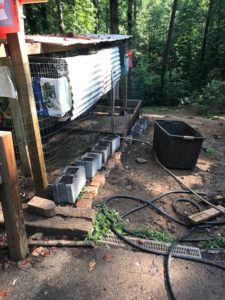
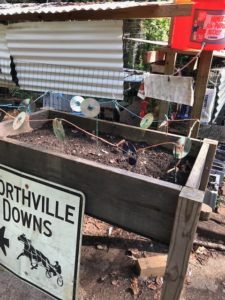
Other news, we found the cat. Unfortunately she had passed, we believe our neighbors dogs got her. I have no proof, but we will definitely be battening down the hatches around here.
Better news, Bertha managed to hatch 7 chicks! All of them are dark grey/black except for one (I’m hoping it’s one of Merle’s). There were two other eggs left that she had stopped incubating to take care of the other chicks, so we have them in the incubator. One had pipped and the other hadn’t begun to hatch yet, but now both chicks are out of their eggs in the incubator. One had some shell stuck to it, so I’m not very confident about its survival, but we will see.
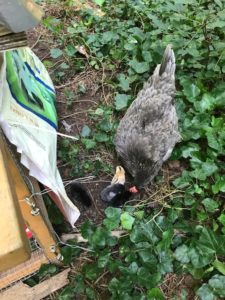
Oh also, Justus is working in the taxidermy shop (finally!!) and the dogs are the happiest about it. They’re his biggest fans. HA!
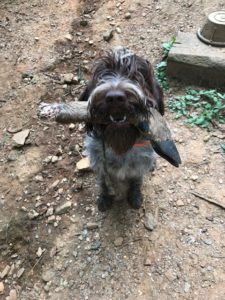
The Bradford Pear

Last weekend, my grandparents visited, and as I know they have a love for gardens, flowers, and all things beautiful, we took them to Gibb’s Gardens. Daffodils, cherry trees, and a couple other early spring blossoms looked gorgeous, flowering across the landscape. One bloom that was absent, however, was that of the Bradford pear. We passed many planted in the yards of homeowners on our drive to the gardens, however the tree was absent there. This absence is for very good reason, as the Bradford pear has become a hugely invasive species, choking out other native trees and plants in its wake.
First, a bit about the Bradford pear. It is originally native to China, and is a sub-species of a group known as the Callery pears, or almost any ornamental pear variety. It can grown between 30-50 feet tall and 20-30 feet wide. It is a rapid grower with a short to moderate lifespan. It is largely disease and pest resistant, and produces fruit through cross pollination with other Callery pear varieties.
Why are they invasive? Simple. Cross pollination of the Bradford with other Callery varieties produces fruit. Birds then eat the fruit, and in doing so, they disperse the seeds across a wide area. These seeds are quick and easy to germinate and grow wild, and due to the cross pollination, they can develop other fruits and thorns that are not seen on parent varieties, resulting in thorny pear thickets. These offspring, known only as Callery pears, grow rapidly and can choke out other native species. The spread of the Callery pears is rampant and shows no signs of slowing down.
If you have any of the Callery varieties planted in your yard, consider cutting them down and replacing them with any other spring-flowering trees, such as: dogwood, redbud, silverbell, cherry, or magnolia. If you suspect that Callery varieties are popping up, be quick to mow them down and treat the mowed stems (we use vinegar & salt, you could also smother them out with a black tarp). Callery pears are very hardy and can grow back from even a simple stump, so full removal is necessary. Consider your native species, and cut down your invasive Bradford pear trees today!
Seed Bombs!
- Determine what sort of bombs you want to make. The simplest are often done with wildflower seeds since they’re
Apple Trees: Sexual Reproduction

So this is something that I don’t think a lot of people are aware of, I myself only just recently found out when reading The Botany of Desire. Pollan is a very interesting and well written author.
ANYWAY, what I’m trying to talk about are apples. Those delicious green or red or yellow, juicy, crunchy, fantastic apples. Did you know that apples are a product of sexual reproduction? An apple can not grow without cross-pollination, a plant’s form of sex. There are a few varieties of apples that are self-fruitful (can be pollinated via pollen from their own flowers), but those trees too are often far more fruitful when cross-pollinated with pollen from another tree.
Cross-pollination will NOT occur if you plant 4 of the same variety of apple trees just because these are different individual trees. Why? Well because, due to sexual reproduction and genetic variation, all apple trees of the same variety are clones from one, yes ONE, single tree. All of the gala, or red delicious, or honey crisp apple trees IN THE WORLD are derived as graphs from their one single original tree.
Think about it…you are genetically different from both of your parents. Certainly, you share some similar traits: eye color, hair color, health factors; but you are NOT a genetic match to your parents, OR your siblings. This is because humans are products of sexual reproduction, or the mixing of genes. Apples reproduce the same way. Cross-pollination allows fruit to grow, and although that fruit will be of the same variety as the parent tree it grows on, the seeds inside of that fruit will possess a very different genetic makeup than that of its parent tree. An apple is simply the ovary of the plant, a vessel for carrying the reproductive unit – the seeds. Cross-pollination does not affect the fruit of the parent tree because apples are a part of the reproductive system, not an outcome of reproduction – as ovaries are part of the human reproductive system and eggs become the outcome of reproduction when fertilized – forming a fetus.
So, while you might have the most BEAUTIFUL golden delicious tree in your back yard, producing juicy, sweet fruit, the seeds inside those golden delicious apples are FAR from similar to the parent plant. Your golden delicious could be cross-pollinated with any number of different species of apple trees. Your neighbor might have some sort of crab apple, or a red delicious, or a crop of cider apples. Any or ALL of these trees likely had some part to play in the cross-pollination of your golden delicious apples, producing seeds that are vastly genetically different than the parent plant from which the apple grew.
Simply put, planting apple trees from seed and expecting a fantastic honey crisp to just pop-up is naive, and frankly it won’t happen. Because all honey crisp trees are grafts of a parent tree, they are all genetically identical – one honey crisp can not successfully cross-pollinate another. What you will more than likely end up with is a crab or cider apple tree. Sure, you’ll get apples, however the likelihood of them being delicious and palatable is slim to none.
Apples are the result of YEARS of trial and error, and for most growers, luck. Apple orchards were originally planted to produce apples for cider and vinegar. These orchards were planted and grown from apple seeds, not grafts, so all of the trees in each orchard were genetically diverse. This genetic diversity meant that the trees were more immune to blight, insects, and disease. Although the apples may not have tasted great, the trees were hearty and strong. Every once in a while, a grower would notice one of the trees in her orchard would look quite different, or possess a different quality that allowed it to stand out from its companions. Most of these differences involved a fruit that was much more palatable and delicious than the others. Other differences included size, shape, color, and of course, taste. When a grower would come across this unique tree, the grafting would begin, and there was money to be made.
There are hundreds of varieties of apples in the world today, however, because all apples of the same variety are clones of the parent tree, apple trees have sacrificed heartiness and immunity for good tasting, desirable fruit. In my opinion, if you’re wanting to plant an orchard of apple trees, do try and grow some from seed. Your best bet is to take seeds from your absolute favorite varieties (mine being honey crisp and granny smith), sprout and plant them. Once your seed-trees have established themselves (after about a year) and are looking strong, then go ahead and plant your clone varieties. So let’s say I’m planning a small orchard of 6 trees, I’m going to plant one granny smith, one honey crisp, and four of my seed-trees. Why? The genetic diversity of seed trees will help prevent pests and blight in your clone trees. The cross pollination of your seed-trees to your clone trees will produce fruit AND new seeds that have (in theory) a 3/4 genetic makeup of your ideal clone plant. It’s all a cycle, you can continue to plant seed-trees from your clone trees in an effort to concentrate genetics and potentially come to a fruit that is similar to your favorite, though does not have the propensity for weakness and disease. It’ll take a good long while, but you could also end up creating the next new delicious variety of apple, all in your back yard!
Poison Ivy

The purpose of this post is to accomplish 3 things:
1. Identify the many forms of poison (ivy, oak, sumac, & the poisonwood tree)
2. Talk about successful and unsuccessful remedies
3. Call out any myths or wives tales about poison
Identification
You need to know what you’re looking to stay away from before you can actually stay
Butcher Day!!

Just some quick specs:
– method of dispatch: cervical dislocation (my homemade hopper popper is currently MIA so I used the broomstick method with equally quick results)
– tools of the trade: scale, hanging string (baling twine), sharp knife for skinning and evisceration, garden shears for easy removal of the feet, gut & blood bucket, head pan (I freeze the heads as dog treats), bowl of water (to keep bloody tools off of the ground), and coat hanger to hang the skins.
– elapsed time from first weight to last carcass in the brine: 22 minutes

If you want to know more about my methodology, see my post here.
Final specs for the three grow outs (11 weeks exactly):
– RR-RE02: 4 lb 5.5 oz – live / 2 lb 0 oz – carcass [46% live to dressed ratio]
– RR-RS01: 4 lb 10.8 oz – live / 2 lb 4.3 oz – carcass [48% LDR]
– RR-RS02: 4 lb 15.5 oz – live / 2 lb 6.2 oz – carcass [ 48% LDR]

My Garden!
– the first year I lived here, I planted a very small, highly unsuccessful garden – the chickens ate nearly everything
– last year, I attempted a straw bale garden, with little to no results (maybe I didn’t age them long enough I think, I also didn’t harden off the seedlings that I started)
– this year, I went “no-till,” mostly because I was forced to, it just got too late and we had so much rain that with my travel schedule I was unable to get the garden tilled in time to plant. I am actually quite happy with the results.

My first step was to put up the fence, because my chickens are notorious for eating freshly planted seeds and sprouting seedlings. Once I got my fence up, I determined what plants I was going to plant. This year I went with the following:
– corn
– sunflowers
– zuchinni
– cucumbers
– pole beans
– bush beans
– tomatoes
– peppers
– melons
Results thus far have been good, I’ve only lost one melon plant (out of the two that I planted), and everything else seems to be thriving. My started seedlings hardened off really well and now they’re going bonkers with all the rain we have had. The only issue that I have each year is my minimal amount of sun – we have some very big trees and unfortunately my garden (in the sunniest spot) only gets about 6 hours of direct sunlight daily. Regardless, the plants all seem to be doing well and there are already some little bitty tomatoes and peppers on the plants. Beans have started appearing also. I long for the days when I can plant a huge, 50×50-ish garden that will get full sun all day long. I can’t wait for that harvest.

I think I’m going to plant some onions when I get back from my July 4 vacation to PA, and then when the days start getting shorter, I’ll add in some greens like lettuces, kale, mustards, and chard. I am also considering putting in a pumpkin, but it might be too late for that, we shall see.
My planting & growing method:
– since I went no till, I mowed down all the grass in the garden area before planting, then I laid out my garden and determined where everything would go. Then I dug the holes, about 6-9″ deep regardless of the plant. I put a BUNCH of bunny poo and old hay (to fertilize and hold in moisture) in the bottom of the holes, filled them at least half way. Then I would plant my seeds or transplant my seedlings into the holes. I broke up the surface soil and packed everything down gently and gave it a good soaking, nature pretty much did the rest. I have tried to be careful about letting the weeds & grasses get too high. I pulled a lot of them from around my tomatoes this week, and I was sort of upset that I did. Living within those weeds & grasses were a TON of insects, arachnids, and other predatory species. I’m sure having these guys living around my plants (because the grasses & weeds provided moisture, shade, and protection) helped keep the bad bugs like worms and aphids away from my garden. I will

keep an eye on things and see how it all progresses.
Overall, I am very happy with my garden this year, I’m looking forward to letting the chickens in once all the plants are very mature, and letting them fertilize and tear up the soil for me. The rabbits have been enjoying eating the weeds. I’ll be excited to start my fall garden as well, and will hopefully have some success with a winter garden in my tiny greenhouse.
If you’d like to see more pictures of the garden, check out the Facebook page. 🙂
Oh yes, just a side note, Elsa AND Francis are sitting on eggs. Happy day!
